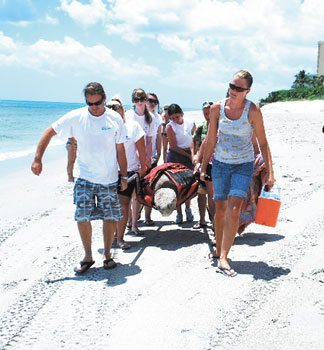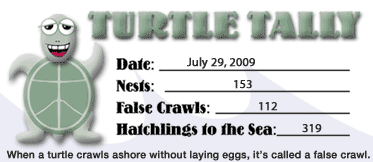Deep hole in sand claims loggerhead

PHOTO COURTESY AMITW
Volunteers carry the body
of a dead loggerhead off the beach on Florida’s east
coast.
The turtle died after falling into a deep hole
that
someone dug in the sand.
Last Thursday, someone went to the shore in Juno Beach on Florida’s east coast. Among the things they did that day was to dig a deep hole in the sand. In all probability, that person or persons had no intention of killing a loggerhead sea turtle, a member of a threatened species.
But a loggerhead sea turtle is dead, nonetheless.
Volunteers for the turtle program there came upon the turtle, which was covered with sand.
"This was one of the saddest mornings I’ve had," said Kelly Martin, a biologist with the Loggerhead Marinelife Center. "She was almost completely covered when we found her, just a little bit of the carapace sticking out. We frantically shoveled the sand off of her head to see if she was breathing. She was not."
The turtle had crawled ashore to nest. She never made it back into the ocean.
Similar deep holes are regularly spotted on Anna Maria Island beaches.
"We had a disorientation a few years ago in Holmes Beach," recalled Anna Maria Island Turtle Watch Coordinator Christina Swosinski. "We spent the morning tracking them down in the sand and vegetation and thought we had them all. Later that morning, we went to take down the stakes of the bird sanctuary about a quarter of a mile away and saw a huge hole."
Swosinski said she mentioned to Susan Camp, her fellow volunteer, that it would be horrifying if some of the hatchlings had wandered off and had fallen into that hole.
"Well guess what?" she asked. "There were several hatchlings in there just baking in the sun."
Camp and Swosinski took the hatchlings out, and they were released at dusk that same evening.
But Swosinski pointed out that the hatchlings had used up a lot of energy scrambling around in the hole, trying to get to the sea — energy that they would need to swim out in the Gulf, evading predators.
"When you have a threatened species like this, each individual matters," AMITW Director Suzi Fox said upon hearing of the death. "This was a mature female, a turtle that survived at least 30 years to make it to reproductive age, and now all the babies she might have created are lost to us forever."
Marine reptiles are threatened by many circumstances — the overwhelming majority of them man made.
Fishing line can become entangled in flippers, leading to infection and the loss of a limb. Earlier this month, a turtle was found that had swallowed a balloon. That turtle survived thanks to intervention by Mote Marine Laboratory scientists who removed the balloon and are hopeful that the turtle can be released back into the Gulf.
It’s believed that pollution puts additional pressure on sea turtle populations, and longline fishing now appears to be a significant threat. A temporary ban on that type of fishing has scientists hopeful that something can be worked out that will protect the turtles while maintaining the viability of the Gulf fishery.
Swosinski said AMITW wages a continuing struggle to inform people of simple things they can do that would make a huge difference to the survival of marine turtles. Things like filling in holes, not taking balloons anywhere near the beach and taking all their trash and beach paraphernalia away from the shore when they leave.
"I have been really encouraged when we go do presentations at Anna Maria Elementary School," Swosinski said. "Almost every child there already knows about the digging rule. It makes me very proud!"



